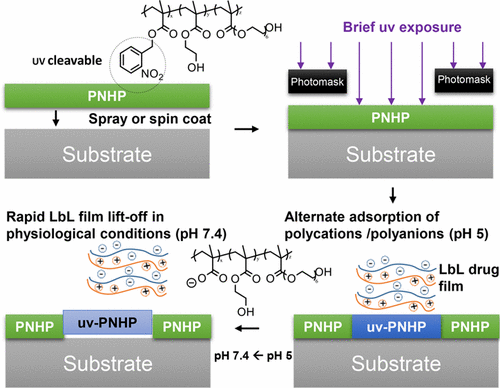当前位置:
X-MOL 学术
›
ACS Macro Lett.
›
论文详情
Our official English website, www.x-mol.net, welcomes your
feedback! (Note: you will need to create a separate account there.)
Synthetic Lift-off Polymer beneath Layer-by-Layer Films for Surface-Mediated Drug Delivery
ACS Macro Letters ( IF 5.1 ) Pub Date : 2017-11-09 00:00:00 , DOI: 10.1021/acsmacrolett.7b00584 Yanpu He , Jiahe Li , Michelle E Turvey 1 , MayLin T Funkenbusch , Celestine Hong , Divakara Ssm Uppu 1 , Hongkun He , Darrell J Irvine 2 , Paula T Hammond 1
ACS Macro Letters ( IF 5.1 ) Pub Date : 2017-11-09 00:00:00 , DOI: 10.1021/acsmacrolett.7b00584 Yanpu He , Jiahe Li , Michelle E Turvey 1 , MayLin T Funkenbusch , Celestine Hong , Divakara Ssm Uppu 1 , Hongkun He , Darrell J Irvine 2 , Paula T Hammond 1
Affiliation

|
A broad range of biomaterials coatings and thin film drug delivery systems require a strategy for the immobilization, retention, and release of coatings from surfaces such as patches, inserts, and microneedles under physiological conditions. Here we report a polymer designed to provide a dynamic surface, one that first functions as a platform for electrostatic thin film assembly and releases the film once in an in vivo environment. Atom transfer radical polymerization (ATRP) was used to synthesize this polymer poly(o-nitrobenzyl-methacrylate-co-hydroxyethyl-methacrylate-co-poly(ethylene-glycol)-methacrylate) (PNHP), embedded beneath multilayered polyelectrolyte films. Such a base layer is designed to photochemically pattern negative charge onto a solid substrate, assist deposition of smooth layer-by-layer (LbL) polyelectrolyte in mildly acidic buffers and rapidly dissolve at physiological pH, thus lifting off the LbL films. To explore potential uses in the biomedical field, a lysozyme (Lys)/poly(acrylic acid) (PAA) multilayer film was developed on PNHP-coated silicon wafers to construct prototype antimicrobial shunts. Film thickness was shown to grow exponentially with increasing deposition cycles, and effective drug loading and in vitro release was confirmed by the dose-dependent inhibition of Escherichia coli (E. coli) growth. The efficacy of this approach is further demonstrated in LbL-coated microscale needle arrays ultimately of interest for vaccine applications. Using PNHP as a photoresist, LbL films were confined to the tips of the microneedles, which circumvented drug waste at the patch base. Subsequent confocal images confirmed rapid LbL film implantation of PNHP at microneedle penetration sites on mouse skin. Furthermore, in human skin biopsies, we achieved efficient immune activation demonstrated by a rapid uptake of vaccine adjuvant from microneedle-delivered PNHP LbL film in up to 37% of antigen-presenting cells (APC), providing an unprecedented LbL microneedle platform for human vaccination.
中文翻译:

用于表面介导药物递送的逐层薄膜下的合成剥离聚合物
范围广泛的生物材料涂层和薄膜药物递送系统需要在生理条件下从贴片、插入物和微针等表面固定、保留和释放涂层的策略。在这里,我们报告了一种旨在提供动态表面的聚合物,该表面首先用作静电薄膜组装的平台,并在体内环境中释放薄膜一次。原子转移自由基聚合(ATRP)用于合成该聚合物聚(邻-硝基苄基-甲基丙烯酸酯-co-羟乙基-甲基丙烯酸酯-co-聚(乙二醇)-甲基丙烯酸酯)(PNHP),嵌入在多层聚电解质膜下方。这种基础层旨在将负电荷光化学图案化到固体基板上,帮助在弱酸性缓冲液中平滑逐层 (LbL) 聚电解质的沉积,并在生理 pH 值下快速溶解,从而剥离 LbL 薄膜。为了探索在生物医学领域的潜在用途,在 PNHP 涂层硅晶片上开发了溶菌酶 (Lys)/聚丙烯酸 (PAA) 多层膜,以构建原型抗菌分流器。薄膜厚度随着沉积周期的增加呈指数增长,有效的载药量和体外释放通过对大肠杆菌(E.coli)的剂量依赖性抑制得到证实生长。这种方法的功效在最终用于疫苗应用的 LbL 涂层微型针阵列中得到进一步证明。使用 PNHP 作为光刻胶,LbL 薄膜被限制在微针的尖端,从而避免了贴片底部的药物浪费。随后的共聚焦图像证实了 PNHP 在小鼠皮肤上的微针穿透部位的快速 LbL 薄膜植入。此外,在人体皮肤活检中,我们通过在高达 37% 的抗原呈递细胞 (APC) 中从微针递送的 PNHP LbL 薄膜中快速摄取疫苗佐剂,实现了有效的免疫激活,为人类疫苗接种提供了前所未有的 LbL 微针平台.
更新日期:2017-11-09
中文翻译:

用于表面介导药物递送的逐层薄膜下的合成剥离聚合物
范围广泛的生物材料涂层和薄膜药物递送系统需要在生理条件下从贴片、插入物和微针等表面固定、保留和释放涂层的策略。在这里,我们报告了一种旨在提供动态表面的聚合物,该表面首先用作静电薄膜组装的平台,并在体内环境中释放薄膜一次。原子转移自由基聚合(ATRP)用于合成该聚合物聚(邻-硝基苄基-甲基丙烯酸酯-co-羟乙基-甲基丙烯酸酯-co-聚(乙二醇)-甲基丙烯酸酯)(PNHP),嵌入在多层聚电解质膜下方。这种基础层旨在将负电荷光化学图案化到固体基板上,帮助在弱酸性缓冲液中平滑逐层 (LbL) 聚电解质的沉积,并在生理 pH 值下快速溶解,从而剥离 LbL 薄膜。为了探索在生物医学领域的潜在用途,在 PNHP 涂层硅晶片上开发了溶菌酶 (Lys)/聚丙烯酸 (PAA) 多层膜,以构建原型抗菌分流器。薄膜厚度随着沉积周期的增加呈指数增长,有效的载药量和体外释放通过对大肠杆菌(E.coli)的剂量依赖性抑制得到证实生长。这种方法的功效在最终用于疫苗应用的 LbL 涂层微型针阵列中得到进一步证明。使用 PNHP 作为光刻胶,LbL 薄膜被限制在微针的尖端,从而避免了贴片底部的药物浪费。随后的共聚焦图像证实了 PNHP 在小鼠皮肤上的微针穿透部位的快速 LbL 薄膜植入。此外,在人体皮肤活检中,我们通过在高达 37% 的抗原呈递细胞 (APC) 中从微针递送的 PNHP LbL 薄膜中快速摄取疫苗佐剂,实现了有效的免疫激活,为人类疫苗接种提供了前所未有的 LbL 微针平台.











































 京公网安备 11010802027423号
京公网安备 11010802027423号